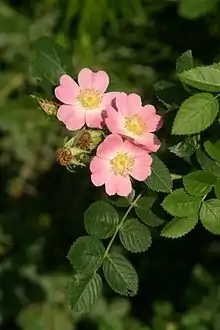| Rosoideae | |
|---|---|
 | |
| Rosa rubiginosa, eglantine rose | |
| Scientific classification | |
| Kingdom: | Plantae |
| Clade: | Tracheophytes |
| Clade: | Angiosperms |
| Clade: | Eudicots |
| Clade: | Rosids |
| Order: | Rosales |
| Family: | Rosaceae |
| Subfamily: | Rosoideae Juss. ex Arn. |
| Tribes | |
The rose subfamily Rosoideae consists of more than 850 species, including many shrubs, perennial herbs, and fruit plants such as strawberries and brambles. Only a few are annual herbs.
The circumscription of the Rosoideae is still not wholly certain; recent genetic research[1] has resulted in several changes at the genus level and the removal from Rosoideae of some genera (notably Cercocarpus, Cowania, Dryas and Purshia) previously included in the subfamily.
Genera
- Acaena – bidibidis
- Agrimonia – agrimonies
- Alchemilla – lady's mantles
- Aphanes – parsley-pierts (sometimes in Alchemilla[2])
- Aremonia
- Argentina – silverweeds (sometimes in Potentilla)
- Bencomia
- Chamaerhodos Bunge[2] – little-rose
- Cliffortia
- Coluria
- Comarum (formerly in Potentilla)
- Dasiphora – woody cinquefoils (formerly in Potentilla)
- Dendriopoterium (currently in Sanguisorba[3])
- Drymocallis – sticky cinquefoils (formerly in Potentilla)
- Duchesnea - mock strawberry (formerly in Potentilla)
- Fallugia[2]
- Filipendula
- Fragaria – strawberries
- Geum – avenses
- Hagenia – African redwood
- Horkelia – horkelias (sometimes in Potentilla[2])
- Horkeliella – false horkelias (sometimes in Potentilla[2])
- Ivesia – mousetails (sometimes in Potentilla)
- Leucosidea – oldwood
- Marcetella
- Margyricarpus – pearlfruit
- Polylepis
- Potaninia[2]
- Potentilla – typical cinquefoils (including Duchesnea)
- Poteridium[2]
- Poterium
- Purpusia (sometimes in Potentilla [4])
- Rosa – roses
- Rubus – brambles and raspberries
- Sanguisorba – burnets
- Sarcopoterium
- Sibbaldia[2]
- Sibbaldianthe
- Sibbaldiopsis – three-toothed cinquefoil (formerly in Potentilla)
- Sieversia[2]
- Spenceria
- Tetraglochin
- Waldsteinia (sometimes in Geum[2])
References
Wikimedia Commons has media related to Rosoideae.
- ↑ Torsten Eriksson; Malin S. Hibbs; Anne D. Yoder; Charles F. Delwiche & Michael J. Donoghue (2003). "The phylogeny of Rosoideae (Rosaceae) based on sequences of the internal transcribed spacers (ITS) of nuclear ribosomal DNA and the trnL/F region of chloroplast DNA" (PDF). International Journal of Plant Sciences. 164 (2): 197–211. doi:10.1086/346163.
- 1 2 3 4 5 6 7 8 9 10 D. Potter; T. Eriksson; R. C. Evans; S. Oh; J. E. E. Smedmark; D. R. Morgan; M. Kerr; K. R. Robertson; M. Arsenault; T. A. Dickinson & C. S. Campbell (2007). "Phylogeny and classification of Rosaceae" (PDF). Plant Systematics and Evolution. 266 (1–2): 5–43. doi:10.1007/s00606-007-0539-9.
- ↑ "Dendriopoterium Svent. | Plants of the World Online | Kew Science". Plants of the World Online. Retrieved 15 December 2021.
- ↑ "Purpusia Brandegee | Plants of the World Online | Kew Science". Plants of the World Online. Retrieved 15 December 2021.
This article is issued from Wikipedia. The text is licensed under Creative Commons - Attribution - Sharealike. Additional terms may apply for the media files.